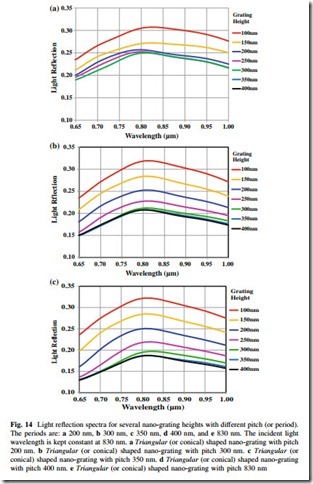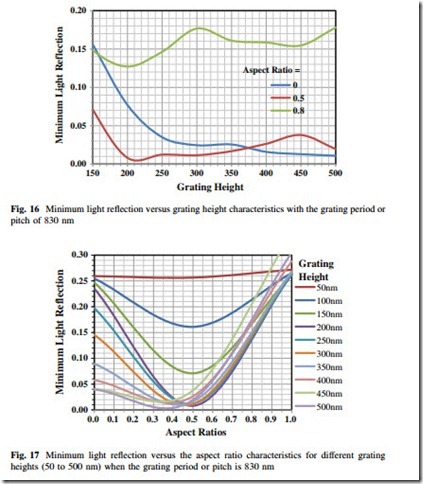Minimum Light Reflection for Different Nano-gratings
This section considered different aspect ratios for the nano-grating period or pitches of 830 nm to obtain the minimum light reflection for GaAs solar cells structure.
Figure 16 shows the minimum light reflection for the grating pitch (period) of 830 nm. For this case, the minimum light reflection is 1-2 % with the nano- grating height of 300-400 nm, when the aspect ratio is ‘0’. However, the light reflection is increased to 1-4 % (with the aspect ratio 0.5) and grating height of 250-450 nm; and reaches to 13-17 % with the aspect ratio 0.8 and the nano- grating height of 200-450 nm.
Figure 17 shows the minimum light reflection versus the aspect ratio characteristics for different nano-grating heights. For this case, the nano-grating height is
varied from 50 to 500 nm. Here, the grating period is kept constant at 830 nm. Here, the aspect ratio is varied from 0 to 1. As discussed earlier, when the aspect ratio is ‘0’ then the shape of the nano-grating is triangular, when the aspect ratio is [0 but 1\ then the shape of the nano-grating is trapezoidal, and when the aspect ratio is ‘1’ then the shape of the nano-grating is rectangular. The results show light reflection for 50 nm grating height is [26 %, which is like a flat type (*30 % light reflection) substrates. From the plot, it shows clearly that when the grating height increasing from 50 to 250–350 nm, then the light reflection is decreasing sharply and drops to 1-2 % (with the aspect ratio of 0.4-0.6). However, further increasing the nano-grating height then the reflection loss is increasing rapidly and reached toward 50 nm grating height.


